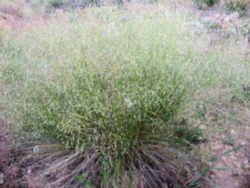
Utah Symbols
- State Resources
- » 50 States
- » Utah
- » Symbols
Utah State Grass
Indian Ricegrass

(Oryzopsis hymenoides)
Adopted on March 13, 1990.
Indian ricegrass, (Oryzopsis hymenoides,) a native perennial bunchgrass, was officially recognized as the Utah State Grass on March 13, 1990 (Utah Code).
Indian ricegrass is an important food for livestock and for wild grazers such as bison, desert bighorn sheep, elk, mule deer, pronghorns, and jackrabbits
Utah State Grass: Indian Ricegrass

Oryzopsis hymenoides
(Synonym: Stipa hymenoides, Common name: Indian ricegrass) is a perennial cool-season[citation needed] bunchgrass with very narrow, rolled leaf blades.It
is native to western North America east of the Cascades from British Columbia and Alberta south to southern California, northeastern Mexico, and Texas.
In the wild it typically grows 4 to 24 inches (10 to 61 cm) tall and 8 to 12 inches (20 to 30 cm) wide.
It grows in a variety of habitats from desert shrub up to ponderosa pine forests. It can live in soils from sand to clay, but it does particularly
well in sand, where it is the dominant grass growing with sagebrush and may occur almost unmixed with other plants
The Society for Range Management´s Utah Section began campaigning for a state grass in the mid-1980s and after studying many species the field was
narrowed to four candidates: Indian ricegrass, bluebunch wheatgrass, galleta grass, and Great Basin wildrye. Indian ricegrass was then selected as
the favorite. The state grass bill was introduced by Senator Alarik Myrin, a member of the Society, in 1989. It was also adopted as Nevada´s state
grass in 1977.
This grass is a fine addition to any xeriscape and will grow quite large if given the room. The open, spangled appearance when in flower or fruit is
very attractive, especially in backlight. In the past, the grass was used as a food staple by the Indians especially when the corn crop failed. Seed
of the ricegrass was gathered and ground into meal or flour and made into bread.
Description: Indian rice grass a cool-season perennial bunchgrass. The ornamental seedheads of this grass can reach heights of almost a meter tall. The bell shaped bracts holding the seeds are its easiest recognized distinguishing characteristic.
Range: Widespread throughout dry areas in the west.
Culture: Found thriving in sandy, dry soils.
Value: The large, rice-like panicle seed head of indian ricegrass is a very striking, fine-textured addition to any landscape, with the best effect achieved by grouping a number of plants.
Propagation: Because it grows in such hot dry places, seed of Indian Ricegrass often needs an afterripening of 1 to 5 years. Many nurseries have used acid scarification to break the hard seed coat. To start seed indoors use a hot water soak of the hottest tap water for 72 hours. Sow in to container and cover to depth. Germination will be very sporadic from 15 to 60 days with many seeds not germinating at all. Placing container on a north face in the fall for the winter after the above treatment may give better results, light mulching is desirable. Seed may also be sown in the desired location. Use quite a number of seeds per site so you can get results faster. Sporadic germination will result over several years.
Utah Law
The law designating the Indian rice grass as the official Utah state grass is found in the Utah Statutes, Title 63, Chapter 13, Section 63-13-5.5 (16).
TITLE 63. State Affairs in General.
CHAPTER 13. Miscellaneous Provisions.
SECTION 63-13-5.5. State Symbols.
63-13-5.5. State symbols.
(1) Utah's state animal is the elk.
(2) Utah's state bird is the sea gull.
(3) Utah's state centennial astronomical symbol is the Beehive Cluster located in the constellation of Cancer the Crab.
(4) Utah's state centennial star is Dubhe, one of the seven bright stars composing the Big Dipper in the constellation Ursa Major.
(5) Utah's state centennial tartan, which honors the first Scots known to have been in Utah and those Utahns of Scottish heritage, shall have a pattern
or repeating-half-sett of white-2, blue-6, red-6, blue-4, red-6, green-18, red-6, and white-4 to represent the tartan worn anciently by the Logan and
Skene clans, with the addition of a white stripe.
(6) Utah's state cooking pot is the dutch oven.
(7) Utah's state emblem is the beehive.
(8) Utah's state fish is the Bonneville cutthroat trout.
(9) Utah's state flower is the sego lily.
(10) Utah's state folk dance is the square dance, the folk dance that is called, cued, or prompted to the dancers and includes squares, rounds, clogging,
contra, line, and heritage dances.
(11) Utah's state fossil is the Allosaurus.
(12) Utah's state fruit is the cherry.
(13) Utah's state vegetable is the Spanish sweet onion.
(14) Utah's historic state vegetable is the sugar beet.
(15) Utah's state gem is topaz, as is prominently found in the Thomas Mountain Range in Juab County, Utah.
(16) Utah's state grass is Indian rice grass.
(17) Utah's state hymn is "Utah We Love Thee" by Evan Stephens.
(18) Utah's state insect is the honeybee.
(19) Utah's state mineral is copper.
(20) Utah's state motto is "Industry."
(21) Utah's state railroad museum is Ogden Union Station.
(22) Utah's state rock is coal.
(23) Utah's state song is "Utah This is the Place" by Sam and Gary Francis.
(24) Utah's state tree is the blue spruce.
Taxonomic Hierarchy: Indian Rice Grass
Kingdom: Plantae - Plants
Subkingdom: Tracheobionta - Vascular plants
Superdivision: Spermatophyta - Seed plants
Division: Magnoliophyta - Flowering plants
Class: Liliopsida - Monocotyledons
Subclass: Commelinidae
Order: Cyperales
Family: Poaceae ⁄ Gramineae - Grass family
Genus: Achnatherum P. Beauv. - needlegrass
Species: Achnatherum hymenoides (Roem. & Schult.) Barkworth - Indian ricegrass







